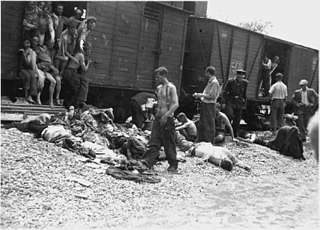Resettlement to the East
Resettlement to the East (German: Umsiedlung nach (dem) Osten) was a Nazi euphemism used to refer to the deportation of Jews and others such as Gypsies to extermination camps and other murder locations as part of the Final Solution.[1][2] The Nazis used the euphemism as an attempt to fool their victims into thinking that they would be "resettled" somewhere else, usually a labour camp, but not all victims believed the claim. The Germans also used the word "evacuation", implying preservation from danger and equally misleading to the victims. The Jews were allowed a small luggage allowance, but the luggage was loaded separately and often was left at the station for disposal later, after the trains left. German Jews and their luggage were collected openly and in full view of the public before their transportation to the local railway station. To keep the lie credible, receipts were given, and the luggage was carried separately and collected from the victims after their murder.[3][4]


Holocaust trains


Most of the victims were carried to their deaths by Reichsbahn trains in locked and windowless cattle wagons, with few sanitary arrangements and little or nothing in the way of water or food. The wagons were supposed to carry just 50 persons but were normally packed with 100 to 150 victims, the overcrowding making sitting impossible and increasing their distress. The Holocaust trains were hired by Adolf Eichmann, and the Reichsbahn demanded one-way fares be paid by the victims although children below the age of four were allowed free travel to their deaths. The trains travelled to local death camps in Poland at Chelmno, Belzec, Treblinka, Majdanek and Auschwitz-Birkenau, but the early trains in 1939 and 1940 also travelled to Nazi ghettos in the east, and the victims were usually murdered there by Einsatzgruppen organized by Reinhard Heydrich. Conditions on the Holocaust trains were so bad that many passengers died en route to the death camps especially as it often took many days to reach their destinations. The cattle cars in which the victims were carried were completely unheated in winter and unventilated in hot weather and so the passengers were exposed to either hypothermia or heat stroke. Deaths among the elderly, children and sick were common. To maintain the deception, some passengers were given postcards by the guards to send to their relatives with dictated words about their successful "resettlement". That decepion continued even to the death camps, such as with a bogus station at Treblinka and Sobibor camps that was complete with signs, a station clock (with a fixed time showing) and flower tubs to reassure the victims who debouched there.[5]
Einsatzgruppen
Einsatzgruppen reports even listed Jews who had been executed locally as having been "resettled": "the euphemistic term "resettled" (ausgesiedelt) was understood to mean something else (erschossen or hingerichtet/shot or executed)".[6] During the war, the Polish underground press already warned foreign media not to accept the claim of resettlement at face value.[7] Holocaust deniers claim that the use of the phrase in Nazi documents refers to the actual resettlement of Jews, rather than their murder, but those claims are rejected by historians.[8]
References
- "Major deportations to killing centers, 1942-1944". encyclopedia.ushmm.org. Retrieved 29 May 2020.
- Snyder, Timothy (2012). Bloodlands: Europe Between Hitler and Stalin. Basic Books. p. 217. ISBN 978-0-465-03297-6.
- Kaplan, Marion A. (1999). Between Dignity and Despair: Jewish Life in Nazi Germany. Oxford University Press. pp. 184, 194, 227. ISBN 978-0-19-983905-6.
- Fischel, Jack (1998). The Holocaust. Greenwood Publishing Group. p. 58. ISBN 978-0-313-29879-0.
- "Major deportations to killing centers, 1942-1944". encyclopedia.ushmm.org. Retrieved 29 May 2020.
- Schmaltz, E. J.; Sinner, S. D. (1 January 2000). "The Nazi Ethnographic Research of Georg Leibbrandt and Karl Stumpp in Ukraine, and Its North American Legacy". Holocaust and Genocide Studies. 14 (1): 28–64. doi:10.1093/hgs/14.1.28.
- Zimmerman, Joshua D. (2015). The Polish Underground and the Jews, 1939–1945. Cambridge University Press. p. 249. ISBN 978-1-316-29825-1.
- Zimmerman, John C. (2000). Holocaust denial: demographics, testimonies, and ideologies. University Press of America. pp. 16–17, 75, 96. ISBN 978-0-7618-1822-9.
Further reading
- Adey, Peter (29 August 2019). "Evacuated to Death: The Lexicon, Concept, and Practice of Mobility in the Nazi Deportation and Killing Machine". Annals of the American Association of Geographers. 110 (3): 808–826. doi:10.1080/24694452.2019.1633904.
`